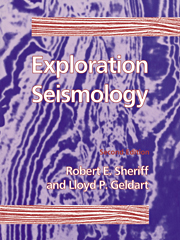Book contents
- Frontmatter
- Contents
- Preface
- Mathematical conventions and symbols
- 1 Introduction
- 2 Theory of seismic waves
- 3 Partitioning at an interface
- 4 Geometry of seismic waves
- 5 Seismic velocity
- 6 Characteristics of seismic events
- 7 Equipment
- 8 Reflection field methods
- 9 Data Processing
- 10 Geologic interpretation of reflection data
- 11 Refraction methods
- 12 3-D Methods
- 13 Specialized techniques
- 14 Specialized applications
- 15 Background mathematics
- Appendices
- Index
5 - Seismic velocity
Published online by Cambridge University Press: 05 June 2012
- Frontmatter
- Contents
- Preface
- Mathematical conventions and symbols
- 1 Introduction
- 2 Theory of seismic waves
- 3 Partitioning at an interface
- 4 Geometry of seismic waves
- 5 Seismic velocity
- 6 Characteristics of seismic events
- 7 Equipment
- 8 Reflection field methods
- 9 Data Processing
- 10 Geologic interpretation of reflection data
- 11 Refraction methods
- 12 3-D Methods
- 13 Specialized techniques
- 14 Specialized applications
- 15 Background mathematics
- Appendices
- Index
Summary
Overview
Knowledge of velocity values is essential in determining the depth, dip, and horizontal location of reflectors and refractors, in determining whether certain things like head waves and velocity distortions occur, and in ascertaining the nature of rocks and their interstitial fluids from velocity measurements.
We develop a heuristic appreciation of the factors that affect seismic velocity from a conceptual model of a sedimentary rock. F. Gassmann, M. A. Biot, and J. Geertsma developed a model for a fluid-filled porous rock, and G. H. P. Gardner, L. W. Gardner, and A. R. Gregory hypothesized that microcracks in nonporous rocks lower velocity.
Fracturing also generally lowers velocity. Lithology is the most obvious factor we would expect to control velocity. However, velocity ranges are so broad and there is so much overlap that velocity alone does not provide a good basis for distinguishing lithology. Sand velocities, for example, can be smaller or larger than shale velocities, and the same is true for densities; both velocity and density play important roles in seismic reflectivity.
Porosity appears to be the most important single factor in determining a rock's velocity, and the dependence of porosity on depth of burial and pressure relationships makes velocity sensitive to these factors also. Velocity is generally lowered when gas or oil replaces water as the interstitial fluid, sometimes by so much that amplitude anomalies result from hydrocarbon accumulations.
The near-surface layer of the earth usually differs markedly from the remainder of the earth in velocity and some other properties.
- Type
- Chapter
- Information
- Exploration Seismology , pp. 107 - 144Publisher: Cambridge University PressPrint publication year: 1995



